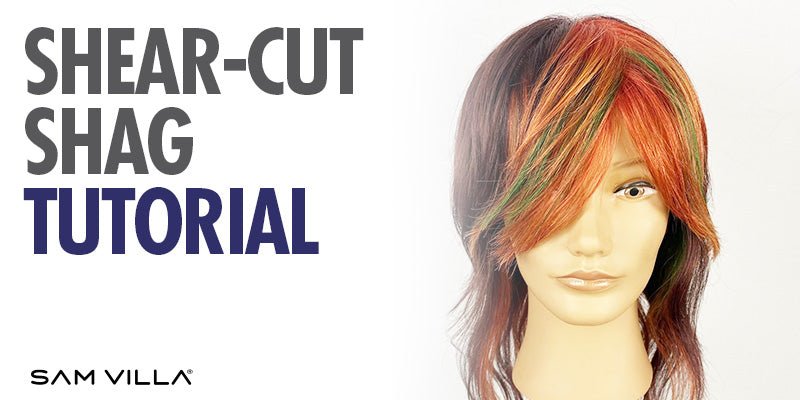Soft, lived-in texture and natural movement are two of today’s hottest hairstyling trends. But creating a beautiful textured cut isn’t as simple as blending, blending and more blending!
Several factors affect your final results, including the elevation, over-direction and shear angle. Cutting at a horizontal angle with the hair in its natural fall will result in a hard line-- even when using blending shears.
By properly sectioning the hair, selecting the right texturizing tool and adapting your techniques for the client’s hair type, you can achieve beautiful texture in less time.
Read on to discover how to texturize different hair types with ease!
Texturizing Ultra-Straight Hair [Face Framing Layers]

Creating a face frame in sleek, straight hair can be a challenge. This hair type tends to fall flat, plus any hard lines will be instantly visible!
For soft, floating short-to-long layers, think about changing up where you cut the hair. Over-direction creates graduation-- and there’s no need to go back and re-texturize after cutting. Follow these steps to cut face-framing layers in super-sleek hair:
Step #1: Identify where your guest parts their hair, and clip one side out of the way.
Step #2: Take a diagonal forward section of hair next to the parting and the face. Place your fingers into the section where you want to create the angle. Over-direct to the opposite side, with the hair elevated just above the face.
Step #3: Weave the blunt end of your reversible blending shear through the section (as you would weave for a highlight). Open and close the shears several times, then push them up toward the head, keeping your fingers in place. Repeat this process until all the hair has been texturized.
Step #4: Determine where you want your face frame to end, and add this hair to the diagonal forward section. Place your fingers into the section where you want to create the angle. Over-direct all of the hair to the opposite side at a below-horizontal elevation.
Step #5: Weave the blunt end of your reversible blending shear through the section (as you would weave for a highlight). Open and close the shears several times, then push them up toward the head, keeping your fingers in place. Repeat this process until all the hair has been texturized.
Step #6: Comb the hair back into its natural fall. Repeat Steps 1-5 on the opposite side for soft, diffused texture.
Texturizing Naturally Curly Hair [Detached Volume]

For our guests with gorgeous natural texture, maintaining weight and length is often the primary concern. But what about when a guest wants more volume in the crown area?
When it comes to texturizing curly hair, remember that the ends need friends. Over-texturizing with a razor or blending shear can lead to frizz when the hair expands. Instead, consider using a standard shear on a detached section to protect density.
Step #1: Take a horizontal section at the crown of the head. Elevate this hair vertically.
Step #2: Weave one blade of the Streamline Series Shear through the section (as you would weave for a thick, chunky highlight). Close the blades around the curls to cut the hair.
Step #3: Comb the hair back over the detached section. The shorter pieces pump up the volume at the crown, while the woven, diffuse texture prevents any holes in the.
Texturizing Blonde Hair [Haircut Refresh]
Many stylists find that blonde hair is the most difficult hair type to layer. The light color (often paired with a fine, smooth texture) means that there is almost NO margin of error!
Sam Villa recommends working a vertical or diagonal shear angle to create softer texture without blunt lines. If you do make a mistake (it happens!) use your comb to separate and vertically elevate the hair that you want to texturize. Remove weight with your blending shear at a diagonal cutting angle, alternating sides for natural movement.
In-between full haircuts, consider offering guests an “Express Service” that includes trimming the ends, the fringe and the face-framing layers. Try these tips the next time you go to refresh a blonde textured haircut:
Trimming the Ends

Place your fingers into the hair just above where you want to cut the ends. Working with a midsize cutting shear (Sam suggests the 6.25” Streamline Shear), cut into the ends at a diagonal angle. Reverse your shear direction and cut into the ends from the opposite side.
The result is a series of small points that form a “zigzag” or crosshatch shape in the hair. Now it’s time to soften up those blunt lines!
Bring your comb underneath the hair, flip the ends up and fan them out. This helps you to visualize the hair in its natural fall. Point cut into the ends with the shear parallel to the hair shaft and the floor. Bring the hair to the shears by rotating the fan as you cut.
Release the hair and admire the soft, natural textured ends!
Updating a Soft Face Frame

Begin by over-directing the hair to the midline, at a low elevation just above the face. Place the blunt edge of the shears under the section. Open and close the shears several times, pushing gently up towards the head as you close.
Continue this process with the rest of the face-framing pieces, then repeat on the opposite side.
Razor Cutting the Fringe

Using a razor opens up new creative possibilities, but it’s easy to be overly aggressive and remove too much hair. Razors can be temperamental, so grip your tool lightly as you work.
To create a gorgeous piecey fringe with a razor, start by sectioning off the fringe area and elevating the hair to a 90 degree angle. Bring all of the hair to the center and fan it out. Hold your razor like a pencil and point cut against the grain of the hair, using a flicking motion of your wrist.
If your guest wants bolder, chunkier texture, you can use this technique on their face-framing layers as well! Concerned about damage to the hair? Prep the strands with Redken One United before razoring. (Just keep in mind that dry cutting will deliver a bolder, edgier result.)
Finishing and Styling
Bring out that beautiful texture with a speedy finishing technique! Simply sweep through the face-framing layers with the Pro Results 3-in-1 Blow Dry Hot Brush, using your hand to shape the hair as you apply warm airflow. It’s all about working smarter, not harder!
Conclusion
Sometimes getting creative behind the chair is as simple as learning new ways to do the same things. When it comes to texturizing, it’s so important to work with intent and purpose. Changing up your shear angle, elevation, over-direction or the tool you use can completely transform the final result.
Remember, texture is all visual and feel! Once you understand the what, how and why behind texturizing, you’ll be able to customize your approach for every hair type and desired outcome. (Sometimes it pays to break a few rules!)
As the trend towards natural, lived-in texture continues, now is the perfect time to develop new skills and build confidence for faster, better texturizing. Grab your mannequin and try out a new technique today!






